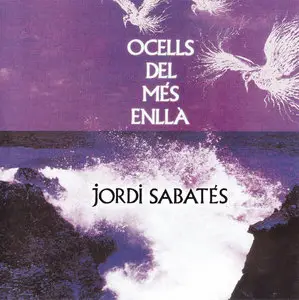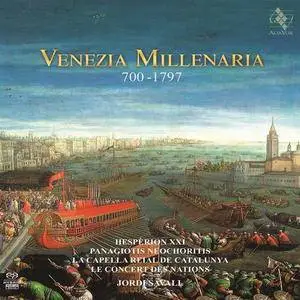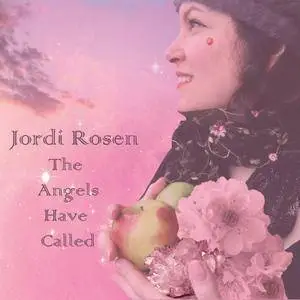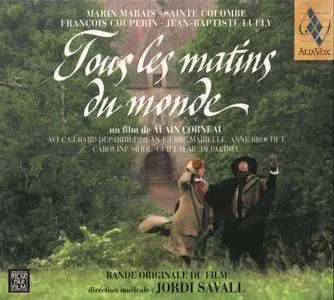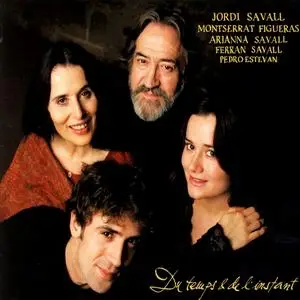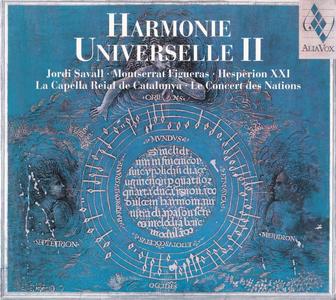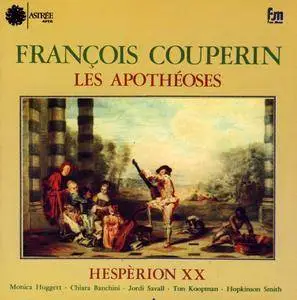Jordi
Jordi Savall - La Folia, 1490-1701 (1998) {Alia Vox AV9805} Music
Posted by ruskaval at June 5, 2018
Jordi Savall - La Folia, 1490-1701 (1998) {Alia Vox AV9805}
EAC rip (secure mode) | FLAC (tracks)+CUE+LOG -> 315 Mb | MP3 @320 -> 128 Mb
Full Artwork @ 300 dpi (jpg) -> 26 Mb | 5% repair rar
© 1998 Alia Vox | AV 9805
Classical / Renaissance / Baroque / Chamber Music
After years of playing the various Folias by Diego Ortiz, Antonio de Cabezón, Antonio Martín y Coll, Arcangelo Corelli and Marin Marais, it became clear to us that there were certain links between the origin and evolution of the important art of musical improvisation and variation and the viola da gamba, or bass viol, itself. In fact, it is no mere coincidence that, throughout the 16th century, and in places as different as France (Adrian Le Roy, 1551), Italy (Vicenzo Ruffo, 1564) and Germany (Matthäus Waissel, 1573), we find references in the various manuscripts and printed documents to the term “gamba”, used as a synonym for “Folia”.
Jordi Savall & Hesperion XXI - Dinastia Borgia - Chiesa e potere nel Rinascimento (2010) [3CD+DVD] {Alia Vox} Music
Posted by ruskaval at May 8, 2018
Jordi Savall & Hesperion XXI - Dinastia Borgia - Chiesa e potere nel Rinascimento (2010) [3CD+DVD] {Alia Vox}
EAC rip (secure mode) | FLAC (tracks)+CUE+LOG -> 1.11 Gb | MP3 @320 -> 534 Mb
DVD5 -> 3.73 Gb | All Regions | PAL 4:3 | Dolby AC3, 2 ch | ~ 81m | ISO Image | Subs: Catala, French, English
Full Artwork @ 600 dpi (jpg) -> 927 Mb | 5% repair rar
© 2010 Alia Vox | AVSA 9875
Classical / Renaissance
Coinciding with the 500th anniversary of the birth of Saint Francis Borgia, Fourth Duke of Gandia, Jordi Savall and Alia Vox offer a visually lavish and artistically comprehensive new release entitled Dinastia Borgia. Savall’s latest musicological/historical quest focuses on music from the time of the Borgia dynasty, including works by composers such as Isaac, Dufay and Morales, from Pope Alexander VI/6 and two of his children, Cesare and Lucrezia, through to Francis Borgia, Jesuit priest and, perhaps, composer. For five centuries, scholars have studied and debated the role of the Borgias in Renaissance history. Although their name is synonymous with Papal corruption and they were undoubtedly malevolent and immoral, as patrons of the arts, the Borgias were also instrumental in the period’s explosive growth of culture.
Jordi Sabates - Ocells del Mes Enlla (1975) Music
Posted by v3122 at Aug. 12, 2015
Jordi Sabates - Ocells del Mes Enlla (1975)
EAC | Flac(Image) + Cue + Log & MP3 CBR 320Kbps
2008 | Picap, 910664-02 | ~ 223 or 104 Mb | Scans Included
Progressive Rock / Jazz Fusion / Jazz-Rock / Ethnic Fusion
EAC | Flac(Image) + Cue + Log & MP3 CBR 320Kbps
2008 | Picap, 910664-02 | ~ 223 or 104 Mb | Scans Included
Progressive Rock / Jazz Fusion / Jazz-Rock / Ethnic Fusion
This is fantastic album of exquisite and delicate prog/fusion from the prolific Spanish scene of the 70s. It features great work by Jordi Sabates (also known for his collaborations with Jarka, Pau Riba, Toti Soler, and for a number of solo piano works) on keyboards, accompanied by drums, percussion, bass, electric guitar, some female vocals and flamenco guitar…
Jordi Savall, Hespèrion XXI - Venezia Millenaria 700-1797 (2018) Music
Posted by tirexiss at March 2, 2018
Jordi Savall - Venezia Millenaria 700-1797 (2018)
EAC | FLAC (image+.cue, log) | Covers Included | 02:34:45 | 833 MB
Genre: Classical, Vocal, Choral | Label: AliaVox | Catalog: AVSA9925
EAC | FLAC (image+.cue, log) | Covers Included | 02:34:45 | 833 MB
Genre: Classical, Vocal, Choral | Label: AliaVox | Catalog: AVSA9925
Despite its hefty, hardbound, 300-plus-page book and attendant top price, Jordi Savall's Venezia Millenaria has appeared on commercial sales charts. It's easy to see why: this is one of Savall's most ambitious concepts, covering the promised millennium of the history of the city of Venice, Italy, plus a bit more as a bonus, taking you up to the end of Venice's independence. The book contains enough information that it could serve as the basis for a little travelers' course, but there's also a case to be made for just listening and letting a thousand years of music wash over you.
Jordi Rosen - The Angels Have Called (2016) Music
Posted by tomashass at March 9, 2016
Jordi Rosen - The Angels Have Called (2016)
MP3 320 kbps CBR |00:47:18 | 109 MB
Genre: Folk, Dreampop, Singer-Songwriter | Label: Jordi Rosen
MP3 320 kbps CBR |00:47:18 | 109 MB
Genre: Folk, Dreampop, Singer-Songwriter | Label: Jordi Rosen
Singer-Songwriter Jordi Rosen resides in Montréal, Canada and was born in Toronto. Jordi started singing at a young age and participated in the school choir, which competed in Canada's Kiwanis Festival. In her teens she studied piano with her esteemed mentor Mrs. Brain. Jordi's innate love and open minded approach to music and art was also influenced by her diverse cultural background with Ojibway and Polish-Jewish parents. After moving to Montreal at age 19 to study at McGill University, Jordi discovered her love of singing and songwriting while playing accordion, jamming with friends Grayson Walker, Bruce Cawdron and Joellen Housego. It wasn't long before she was performing in various combinations at venues throughout Montreal, Eastern Canada, Toronto and New York. She has gone on to explore and compose with a variety of instruments including a Casio keyboard, bowed psaltery, autoharp and most recently the omnichord.
Jordi Savall & Le Concert des Nations - Tous les matins du Monde (2001) {Alia Vox CD & Bonus CD AV9821} Music
Posted by ruskaval at Oct. 9, 2016
Jordi Savall & Le Concert des Nations - Tous les matins du Monde (2001) {Alia Vox CD & Bonus CD AV9821}
XLD rip (secure mode) | FLAC (tracks)+CUE+LOG -> 694 Mb | MP3 @320 -> 326 Mb
Artwork @ 300 dpi (png) -> 151 Mb | 5% repair rar
© 2001 Alia Vox | AV9821 / BE-AV9821
Classical / Baroque / Chamber Music / Bass Viola da gamba
The 1991 French film Tous les matins du monde (All the Mornings of the World) attracted an audience of unexpected size for a story about French Baroque viol music, becoming a runaway hit in France and Germany and even gained wide distribution in the classical-chary U.S. The commercial ramifications grew with the release of the film's soundtrack, featuring early music giant Jordi Savall on viol; the soundtrack achieved platinum sales levels in its initial release. The film's story, built on a very few sketchy facts about the reclusive seventeenth century viol player known only as Monsieur de Sainte Colombe, drew viewers with its modern resonances touching on the conflict between art and popular success, and partly with its dramatic lighting reminiscent of the paintings of Louis le Nain. The soundtrack has a few pieces with vocals or with a small ensemble of other players.
Montserrat Figueras, Jordi Savall, Arianna Savall, Ferran Savall, Pedro Estevan - Du temps & de l’instant (2005) Music
Posted by tirexiss at Aug. 8, 2019
Montserrat Figueras, Jordi Savall, Arianna Savall, Ferran Savall, Pedro Estevan - Du temps & de l’instant (2005)
EAC | FLAC (image+.cue, log) | Covers Included | 01:17:58 | 397 MB
Genre: Classical Vocal | Label: Alia Vox | Catalog: ASVA 9841
EAC | FLAC (image+.cue, log) | Covers Included | 01:17:58 | 397 MB
Genre: Classical Vocal | Label: Alia Vox | Catalog: ASVA 9841
Instead of focusing on a single work or repertory, Jordi Savall, together with his wife Montserrat Figueras and their children Arianna and Ferran Savall, here offers what he terms "a highly personal selection of the music that has moved us by its tenderness and beauty, as well as its ability to promote dialogue and harmony." Thus we have melodies and mostly improvisatory instrumental pieces from a variety of traditions, opening with an absolutely delectable love song by the thirteenth century Galician-Portuguese troubador Martin Codax, and proceeding through music from Afghanistan, Morocco, Sephardic Judaism, France, Mexico, and the inspiration of the various Savalls themselves, among various other sources.
Jordi Savall - Harmonie Universelle II (2004) {Alia Vox AV9839} Music
Posted by ruskaval at Dec. 1, 2020
Jordi Savall - Harmonie Universelle II (2004) {Alia Vox AV9839}
EAC rip (secure mode) | FLAC (tracks)+CUE+LOG -> 379 Mb | MP3 @320 -> 188 Mb
Full Artwork @ 300 dpi (jpg) -> 80 Mb | 5% repair rar
© 2004 Alia Vox | AVSA 9839
Classical / Medieval / Renaissance / Baroque
Harmonie Universelle II illustrates the great historical diversity and range of repertory (from the 15th century to the beginning of the 21st century, in both thematic albums and recordings of works from the great repertory) as well as the wide range of musical formations (solo viol, small instrumental ensemble, solo vocalist, solo orchestra, orchestra and choir, opera) to be found on Alia Vox, an artists’ label created in 1998 by the two great early music exponents: Jordi Savall and Montserrat Figueras. Also featured in this new portrait is an extract from an opera by Vicente Martín y Soler on a libretto by Da Ponte, Il Burbero di buon cuore, recorded in Montpellier in 1995 – a rare opportunity to hear a performance not available on disc.
Jordi Savall & Le Concert Des Nations - Handel - Water Music & Music For The Royal Fireworks (2008) {Alia Vox AVSA 9860} Music
Posted by ruskaval at Oct. 18, 2017
Jordi Savall & Le Concert Des Nations - Handel - Water Music & Music For The Royal Fireworks (2008) {Alia Vox AVSA 9860}
EAC rip (secure mode) | FLAC (tracks)+CUE+LOG -> 412 Mb | MP3 @320 -> 173 Mb
Full Artwork @ 300 dpi (jpg) -> 76 Mb | 5% repair rar
© 1993, 2008 Alia Vox | AVSA 9860
Classical / Baroque / Orchestral
This is a reissue of a recording from 1993 (re-released a few years ago and deleted in 2003), recently remastered for SACD, and it really impresses with a renewed presence and impact, even on standard CD playback. As I said in my original review, Savall's reading "comes as close as these things can to placing us in the best seat in the house and treats us to a rare experience: the sensation of believing we're hearing a ruggedly familiar piece for the first time. Literally bursting with energy, scintillating strings, blazing horns, and incisive winds, and never boring even for one second, these performances give you Handel at his most exciting." If you have the earlier release, you probably don't need this one–unless you now own an SACD system–but it does deserve a place in every Handel collection, not only for the unsurpassed performances, but also for the effect of Savall's several decidedly "non-standard" tempos(!), and of course for the phenomenal sound, which now must have reached its ultimate realism in this format.
Jordi Savall & Hespèrion XX - Couperin - Les Apothéoses (1986) {Astrée-Auvidis E 7709} Music
Posted by ruskaval at June 19, 2018
Jordi Savall & Hespèrion XX - Couperin - Les Apothéoses (1986) {Astrée-Auvidis E 7709}
EAC rip (secure mode) | FLAC (image)+CUE+LOG -> 258 Mb | MP3 @320 -> 118 Mb
Full Artwork @ 300 dpi (jpg) -> 15 Mb | 5% repair rar
© 1986 Astrée (Auvidis) | E 7709
Classical / Baroque / Chamber Music
Couperin’s synthesis of French and Italian styles reached a peak in two works of the 1720s which reveal his refined assimilation of their contrasting essentials. The shorter of them, L’apothéose de Corelli, pays tribute to Couperin’s older Italian contemporary in a Grande sonade en trio. L’apothéose de Lully, containing elements both of sonata and suite, is more complex, with a programmatic element signposted with carefully positioned tempo markings and a profusion of descriptive titles. Jordi Savall and Hespèrion XX provide lively, idiomatic performances employing a mixed ensemble – Couperin did not specify instrumentation; but some readers may, like me, find the spoken introduction to their movements irritating, especially since they are reproduced in the accompanying leaflet.
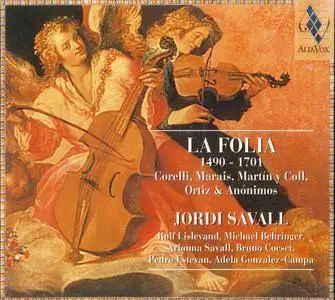
![Jordi Savall & Hesperion XXI - Dinastia Borgia - Chiesa e potere nel Rinascimento (2010) [3CD+DVD] {Alia Vox}](https://pixhost.icu/avaxhome/fc/c3/0036c3fc_medium.jpeg)
